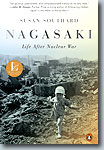

Nagasaki:
Life After Nuclear War
Nagasaki: Life After Nuclear War essentially begins where John Hersey�s famous 1946 work Hiroshima ends. Southard
benefits from access first and foremost to the survivors she renders with a gentle reverence and sympathy. Americans have
largely avoided stories from the point of view of the surviving civilian populations of the only two atomic attacks because
of our inward-gazing moral questioning and, redoubling the erasure, because Hiroshima, the first victim, tends to obscure
Nagasaki. Southard�s work thus illuminates an absence in our own history. Far beyond a reductionist argument about whether
to use nuclear weapons, this is a profound inquiry into the extremes of human violence and what it does to both victim and
victimizer. It is essential reading in our hyper-violent time.
The immediate and long-term devastation caused by the atomic bombs dropped on Hiroshima and Nagasaki is almost too horrific
to comprehend. By focusing on the life stories of five hibakusha (survivors), Southard provides a multifold way to
enter not just into a historical subject but into their subjectivity. A superb researcher, she meticulously gathers medical,
historical, scientific, military, religious, and artistic sources to produce a comprehensive account. The narratives are
nightmarish, of course, making this a book you scarcely want to read, yet its mature literary voice makes it impossible for
the reader to turn away.
There has long been debate in literary and artistic circles about the dilemmas of representing violence and about the potential
for �re-victimizing.� (Among works tackling the subject, there is, famously, Susan Sontag�s Regarding the Pain of Others.)
Southard does not shirk from graphic details but always avoids the modifiers that would turn an image lurid. Her writing is
deeply ethical, ever mindful of context, allowing the voice of the �other� to speak directly to us often in dialogue that
includes phrases of transliterated Japanese.
Most of the hibakusha Southard profiles wound up devoting their lives to disarmament and peace, and this is an important,
vivid document of the ultimate horror of war and the survivors� dedication to never letting us forget.
- Rub�n Mart�nez
2016 finalist judge
* * *
Excerpts from the book
�Again, Do-oh drifted into unconsciousness. This time she hallucinated, seeing images of herself
walking barefoot along an endless path between rice paddies, with vast fields of bright rape blossoms
all around. Yellow and white butterflies flew over the meadows. �It was a world where no one goes,�
she recalled, �an extremely lonely, isolated world.� In the dream, she sat on a rock. In the distance,
an old man in a white kimono beckoned her close to him. As she tried to approach him, another voice
awakened her with a small whisper: �Don�t sleep! Don�t sleep!� It was God�s voice, the creator�s
voice, Do-oh later believed, calling her back from the edge of death.�
�With few exceptions, [American] news stories out of the atomic-bombed cities were abstract and
impersonal, focusing on the rebuilding of the cities, healing and rebirth out of the atomic ashes, and
potential reconciliation with the United States that � according to American journalists � many atomic
bomb victims desired. Reporters typically referenced the atomic bombings in the context of government
calls for heightened civil defense policies, appeals for international control of atomic energy, or
praise of U.S. scientific ingenuity and achievement. Photographs of the mushroom clouds become the
iconic images of the atomic bombings, with no representation of the hundreds of thousands who died
and suffered beneath them.�
�[The hibakusha] chose to relive excruciating memories and exposed themselves to alienation from family
members, harsh judgment for publicly airing their anguish, and right-wing Japanese citizens� untrue
labeling of them as liars or communists. Speaking candidly about their personal experiences provided
each a unique opportunity to influence a world they saw as both obsessed with nuclear weapons and
fundamentally ignorant about their real-life consequences. They were kataribe � storytellers in the
centuries-long Japanese tradition by which selected individuals pass on historical information to their
fellow citizens and future generations.�

|